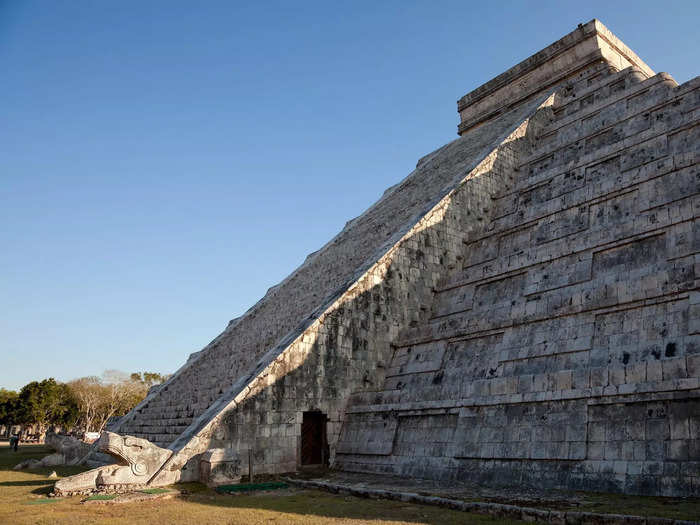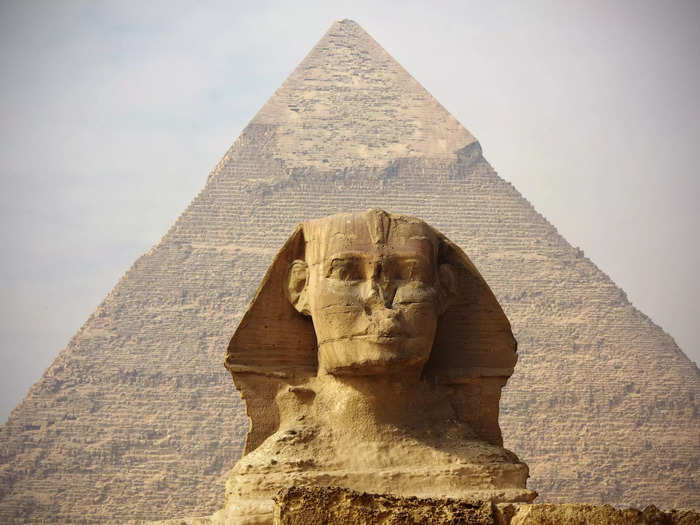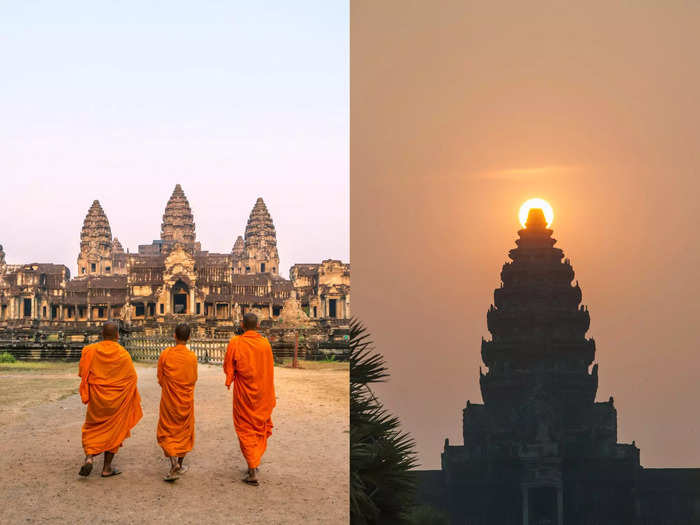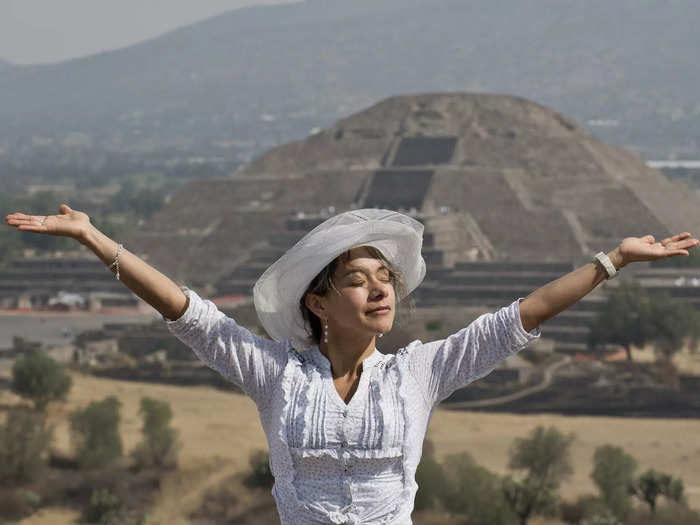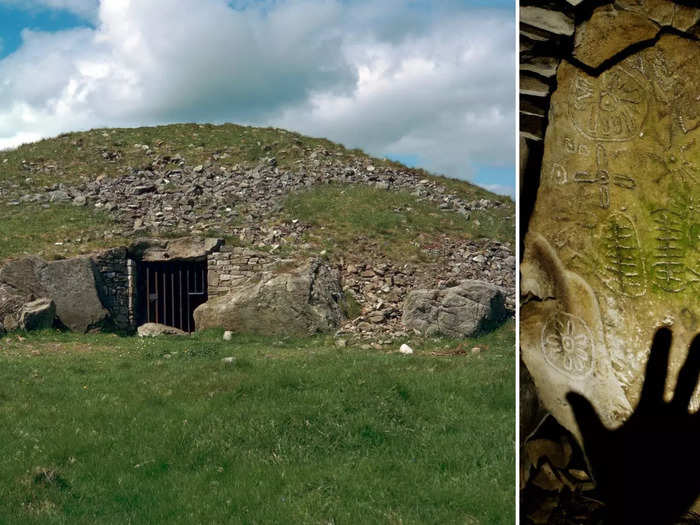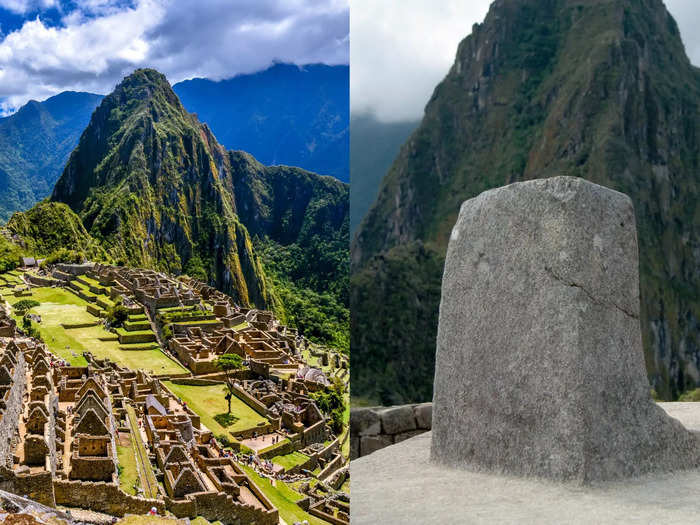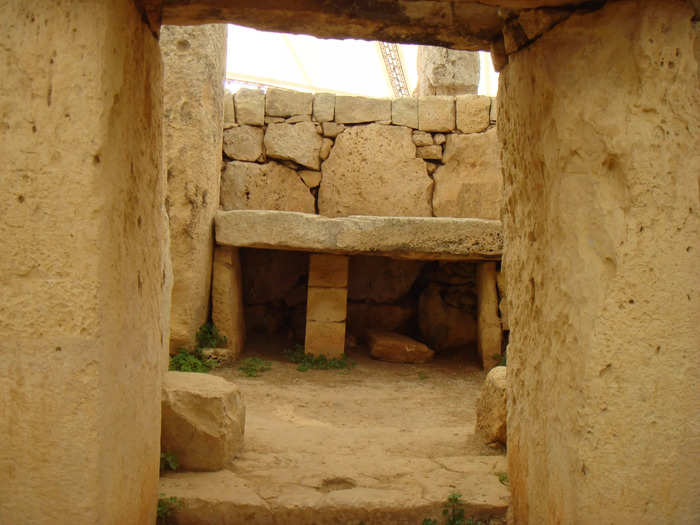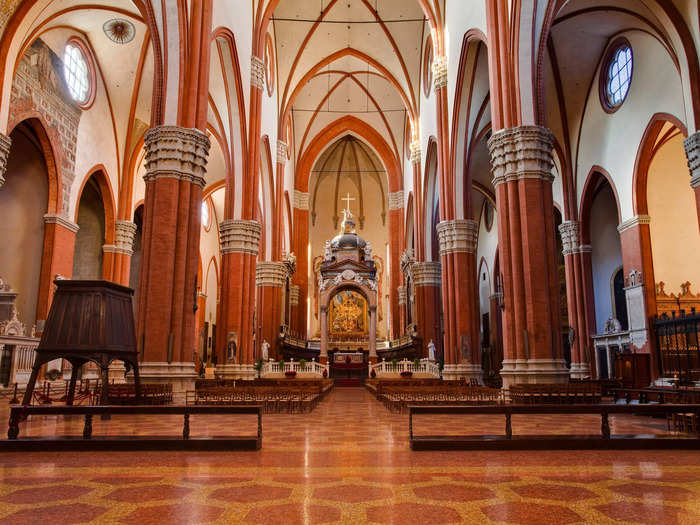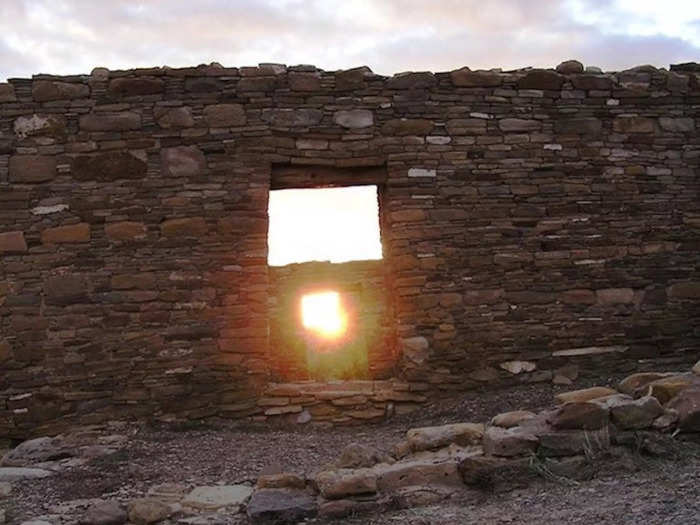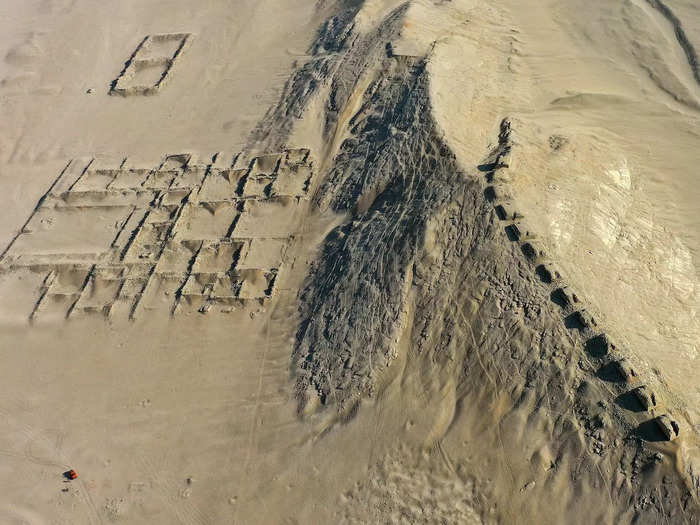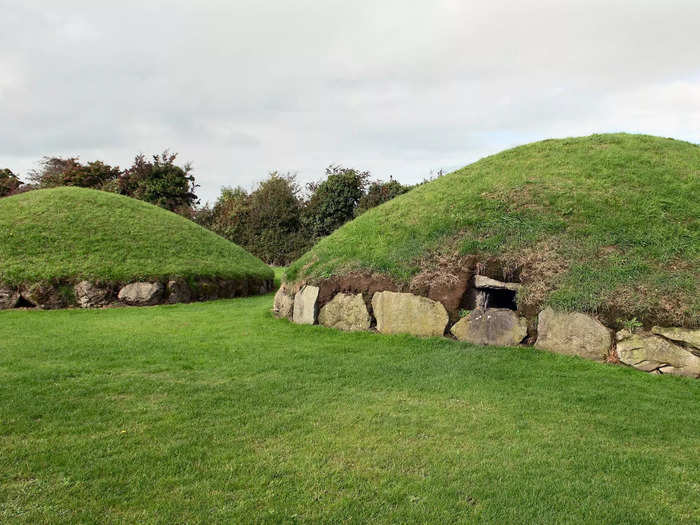From top left clockwise, Teotihuacán in Mexico, Angkor Wat temple in Cambodia, the Great Sphinx and Pyramid of Khafre in Egypt and the Knowth Neolithic passage grave in Ireland.Ronaldo Schemidt/AFP via Getty Images; Cavan Images/Getty images; UniversalImagesGroup / Contributor/Getty Images; oversnap/Getty images
- The spring equinox will take place this year at 17:24 ET on March 20.
- The event marks the start of spring, where day and night are almost equal in length.
There are many reasons to celebrate the spring equinox. For one, it's the time when days start getting longer than nights.
For millennia, people all over the world have marked this mystical occasion, which often symbolizes the beginning of spring or a time of rebirth.
Archaeologists have found many ancient sites that line up with the equinox. But the purpose of these sites often remains shrouded in mystery.
As the spring equinox is around the corner — at 17:24 ET on March 20 — we look at 11 sites that line up with the equinox, and what experts think about them.
Chichén-Itzá pyramid, Mexico
The Chichen Itza pyramid on the spring equinox. BornaMir/iStock/Getty Images
On the spring equinox, tourists and locals gather at the Chichén-Itzá pyramid in Southern Mexico.
As the sun sets in the afternoon, it casts a shadow on the northern staircase that lines up with a carving of a snake's head on the bottom of the stairwell, giving the impression that a snake is slithering down the pyramid.
This is likely to represent the plumed serpent god Kukulkán or Quetzalcóatl coming down to Earth on that day.
Pyramid of Khafre and the Great Sphinx, Egypt
The Sphinx at Giza in Cairo set against the Pyramid of Khafre. Getty Images
Swiss archaeologist Herbert Ricke made a fascinating observation in the 1960s.
The Great Sphinx and the Pyramid of Giza line up perfectly with the sun on the equinox. The sun, he said, seems to sink between the sphinx's shoulders. In fact, the 24 pillars that are left of the Sphinx Temple also seem to be aligned with the equinox sun.
"At the very same moment," Lehner said, per the Smithsonian magazine, "the shadow of the Sphinx and the shadow of the pyramid, both symbols of the king, become merged silhouettes."
Angkor Wat temple, Cambodia
Angkor Wat temple. The equinox sun lines up with the temple. Matteo Colombo/Getty Images; Cavan Images/Getty Images
On the spring equinox, the sun rises exactly on the central peak of the temple in Cambodia called Angkor Wat.
The building leads into a 700-year old city made up of canals, temples, shrines, and tombs spread over 154 square miles, in the jungle of northern Cambodia.
Teotihuacán, Mexico
A woman celebrates the spring equinox at Teotihuacan, Mexico, on March 21, 2013. Ronaldo Schemidt/AFP via Getty Images
Every year during the spring equinox, people gather at the pre-Hispanic site of Teotihuacán, Mexico, in white and red clothing, to celebrate the sun.
Like their ancestors, celebrants climb the pyramid at the site, keeping their arms outstretched while facing the sun as they ask gods for energy and health.
According to some reports, equinox light filters into the Palace of Quetzalpapálotl in Teotihuacán, built around 450 to 500 AD. The light, per the reports, illuminates celestial figures in the walls of the Palace between 7:15 and 7:45 a.m., suggesting the temple was used as a solar observatory.
Loughcrew Cairns, Ireland
A photo montage shows Cairn T at Loughcrew, next to a picture of the Black Stone. CM Dixon/Print Collector/Getty Images; Niall Carson/PA Images via Getty Images
The Loughcrew cairns, in County Meath, Ireland, also known as the Hills of the Witch, is one of the four main passage tomb cemeteries built by humans over 5,000 years ago.
On the spring and fall equinox, the sun shines straight down the entrance of one of the cairns, called Cairn T, illuminating the black stone. This a slab covered in some of Ireland's most beautiful examples of Neolithic art, per Ireland Heritage.
Intihuatana Stone, Macchu Picchu
A photo montage shows Macchu Picchu on the left and the stone on the right. Archeologists think the stone lines up with the equinox sun. Go Ga/Getty Images; FernandoPodolski/istock/Getty Images
The sun was a central figure in Inca worship.
On the site of Macchu Picchu is the Intihuatana Stone, a large square rock that archaeologists have spotted lines up so perfectly with the sun on equinoxes that it casts no shadow.
Many believe the stone could have been used as a solar calendar, though some archeologists say there's insufficient evidence to support this.
Mnajdra megalithic temple, Malta
A megalythic temple in Malta is shown here. UNESCO
Seven megalithic temples found on the islands of Malta and Gozo in the Mediterranean are world heritage sites. These prehistoric structures were built between 4,000 BC and 3,000 BC.
On the spring and autumn equinox, a brilliant ray of sunshine hits the entrance of the temple and lights up the main axis of the building perfectly.
Whether prehistoric humans aligned the temple to the sun intentionally is still a matter of debate, but the orientation is "so systematic that this is very probable," per Malta's national agency for museums, conservation practice and cultural heritage.
Basilica San Petronio, Bologna
An Italian astronomer calculated the distance to the sun on his quest for the equinox at the Basilica San Petronio Julian Elliott Photography/Getty Images
The Basilica San Petronio in Bologna, Italy, gets a special mention as it helped Italian astronomer Giovanni Cassini, who set out to figure out the exact date of the equinox, make the first reasonably accurate prediction of the distance between the sun and the Earth, thanks to a pinhole camera mounted in the Basilica ceiling.
In 1651, Cassini tracked the light that shone through a small hole in the ceiling of the left of the basilica onto the floor, every day at midday.
His purpose was to assess whether easter, which should line up with the spring equinox, was falling on the right date in the newly-introduced Gregorian calendar.
By observing that the projected sunlight grew and shrunk throughout the year, Cassini was able to determine when the Earth was closest and farthest from the sun, proving that the Earth's orbit around the sun was not circular, but elliptical.
Tourists still visit the basilica to see the sunlight hit the floor where Cassini would have seen it.
Chaco Canyon, New Mexico
Chaco's great kiva, Casa Rinconada, during the equinox. National parks service
Chaco Canyon in New Mexico provides many opportunities to observe how the knowledge of the Ancestral Puebloans, who built the site around in 850 CE, of astronomical events.
The canyon is peppered with pictographs of the crescent moon, a ten-pointed stars, which have been interpreted as a representation of a star that exploded in 1054, and sun daggers that fall straight in the middle of pictoglyphs during the solstice.
One of the most striking examples of the Puebloans' knowledge of the solar calendar, though, happens on the fall equinox, when the sun rises through the doorway of an ancient great kiva, a home built in a pit in the ground called Casa Rinconada.
Chankillo, Peru
Aerial view of the Chankillo Solar Observatory near Casma, Peru, on July 22, 2021. JANINE COSTA/AFP via Getty Images
The Chankillo site in the Casma Valley, North Central Peru, was likely a ceremonial center dedicated to the cult of the sun.
Built around 250-200 BC, 13 cube-shaped towers stretching along the ridge of a hill tracked the entire annual solar rising and setting arcs as viewed from two distinct observation points, per UNESCO.
The towers helped people at the time track the equinoxes and solstices with an accuracy of one or two days, an "outstanding example of ancient landscape timekeeping," per UNESCO.
Knowth, Ireland
Knowth in Ireland. UniversalImagesGroup / Contributor/Getty Images
At the same site as the Newgrange megalithic monument stand two ceremonial mounds that date back 5,000 years, even older than Stonehenge.
The mounds have openings lining up with east and west orientations. It is much clearer that Newgrange is aligned with the sun on the solstice, but Knowth's east and westward orientations suggest that they could have been used for ceremonies celebrating the equinoxes, though this has been debated.

